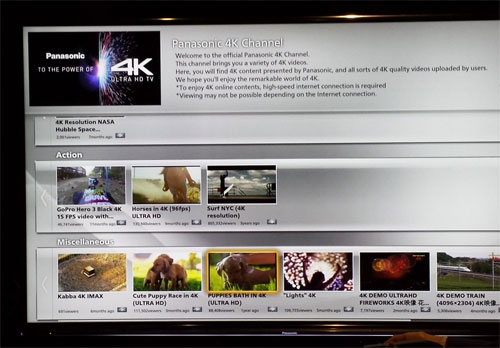Call it what you like. Whether it’s “4K”, “Ultra HD”, or simply “UHD”, there’s no stopping the rapid rise of 3840×2160 resolution TV as it evolves from futuristic concept to something that every living room absolutely has to have. Okay, so we’re not quite there yet, but appreciation of the new display technology is growing fast. Within the next few years, millions of consumers will have gotten their hands on a shiny new, ultra high-definition television displaying crystal-clear, vivid images that most could have only dreamt about just a few years ago.

That much was made clear by the Consumer Electronics Association’s (CEA) Brian Markwalter when he took the stage at the an Ultra HD Conference held in New York yesterday. In his speech, Markwalter pointed to analysts’ research which predicts that shipments of 4K UHD TVs are set to rise from just 57,000 this year to an astonishing 4 million units by 2017.
With the new technology already going mainstream, the CEA recently tried to clear up any ambiguity about it, endorsing “Ultra High Definition” as the official term describing such TVs, in an attempt to do away with “4K”. Of course, not everyone agreed, with brands like Sony and Panasonic preferring to combine the two terms, describing their own super hi-res televisions as “4K Ultra HD”. Meanwhile, many publications (like us here at HDTVTest) have tended to stick with just “4K” which we think is simpler and more likely to catch on.
Now, the CEA is claiming that it was right to anoint “Ultra HD”, stating that consumers have quickly picked up on the term. A recent study conducted by the organisation found that 55% of those surveyed recognised and understood the term, while 64% also knew what “Ultra High Definition” is. In comparison, just 27% of respondents said that they’d heard of the term “4K”.
To be fair, the issue isn’t entirely settled just yet – it’s only the CEA that’s claiming victory, and most likely that’s only because selected compliant media outlets have been forcing “Ultra HD” down everybody’s throat, which has nothing to do with the moniker being any more catchy or memorable. There are arguments for using both terms to be fair, we’ll give them that. 4K isn’t exactly the most accurate description given that the 3840×2160 resolution falls somewhat short of 4096×2160. In this regard, “Ultra HD” might be a better word, but then again, who gives a damn about a few dozen pixels, right?
In contrast, a simple “4K” is a lot easier to spit out or write, and as CNet’s Ty Pendlebury correctly pointed out, when it comes to technology, the shorter name usually comes out on top. He cites the examples of HD-DVD versus Blu-ray, Digital Compact Cassette versus Mini Disc, Betamax versus VHS – and in every case, we always go for the simplest possible description.
There’s also a very logical argument that 4K is just, well, more sensible. Over in Japan, the likes of NHK are already developing the technology to broadcast in 8K resolution, and if the CEA gets its way, what the hell will they try to foist on us next, maybe “Super Ultra High Definition”?
Somehow, we can’t see a tongue-twister of a name like that catching on, can you?
Source: Twice.com

I love the fact that the resolution is getting higher but the fact they changed from saying 1080P (height) to now 4K (width) to make it sound better because saying 2K just doesn’t do it.
8k is also called “Super Hi Vision”, i would choose a shorter version – “Ultra Definition” for 4k, or maybe 8M for 8 megapixels? and what happened with the “Quad Full HD” version? :)